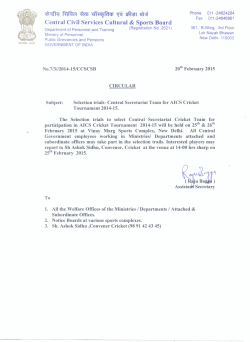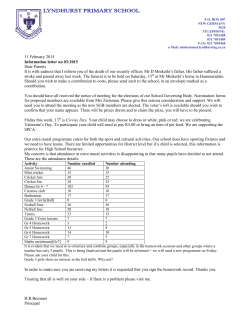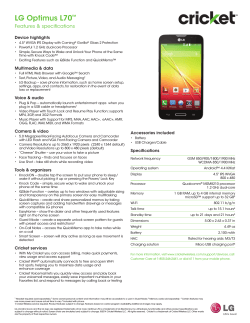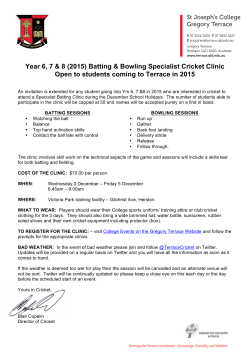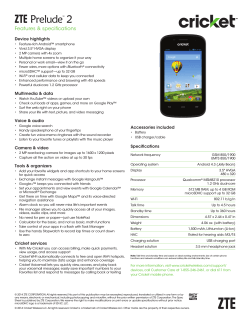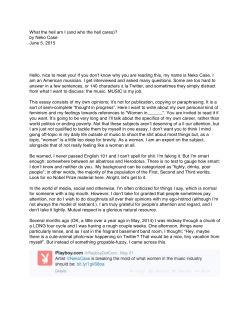
PULSE 43 - MARKET-HUB Stock Broking Pvt Ltd
43 30-04-2015 Our lifeline at Nirmal Bang 2 From The HR Desk A Note From The HR Team 3 North-East-West-South 7 HR Quotient Why Daily Planning is Critical For Focus? 10 Stalwarts Richie Benaud 14 Page Turners Checklist Manifesto 16 Movie Mania Court 19 Travel Bug Malvan 23 Body and Soul 10 Truths We Forget Too Easily 27 Foodie’s Delight Summer Special - Pachadi Summer Special - Aam ki Chutney 29 Techno Zone Five Best Travel Planning Apps 33 Best Employee Of The Month 34 Fabulous Forwards Never give up, pursue your passion 35 Word Play Oxymorons are figures of speech in which two contradictory terms are combined 36 Quizzical From The HR Desk Daily planning is important to focus attention on top priorities for the day, ensuring that we have a laser-like focus on what we want to accomplish during the day. Pulse lists out steps that people can follow to plan the coming day in the article ‘Are You a Prioritizer, Planner, Arranger or Visualizer?’ in HR Quotient. Richie Benaud, Australian cricket captain and the sport's most famous television commentator, who died in Sydney recently aged 84, was a much admired man. He is not only known for his game but also for being the voice of cricket. Acclaimed surgeon and writer Atul Gawande finds a remedy to tackle immensely complex problems with the humblest of techniques: the checklist in his book ‘The Checklist Manifesto: How To Get Things Right’. Marathi film Court is a courtroom drama, which focuses on the trial of an ageing folk singer who has been arrested for abetting a sewerage worker’s suicide through his supposedly inflammatory songs. It’s surprising how easy it is to lose sight of the important things in life. Busy schedules and weekly routines have a tendency to put the brain on autopilot. Some of life’s essential truths need repeating. Pulse provides you with a list that will hopefully come handy when you need a boost in life in the article 10 Truths We Forget Easily in Body and Soul. Malvan and Tarkarli are great destinations for travel junkies. Nirmal Bang employees share the experience of the four-day trip they undertook to these exotic locations early this month and explain why it is a must-visit for others too. Unlike in the previous month, we have received an amazing response for Quizzical and hope this will continue in the future. Finally, we would welcome any comments you have on how you would like to see the magazine develop, particularly if you feel you have something to contribute to its future success. Please send in your contributions to pulse.hr@nirmalbang.com. On a concluding note, we would like to pray for the lives lost in the devastating earthquake in neighbouring Nepal and the safety and wellbeing of the survivors. Our heart goes out to all those people who died in the natural calamity. 22 North-East-West-South An Electrifying Run At Paris Marathon MUMBAI: Rakesh Bhandari, Director, NBSPL recently ran in the 39th Schneider Electric Marathon de Paris alongside 54,000 co-runners. It is one of the biggest marathons in the world, and known as much for the size of its field as the performances of its runners. Nearly 140 nationalities and 50,000 runners come to tackle the most fabled long-distance discipline in athletics. In April, this race across Paris, taking in the Champs Elysées, the Bois de Vincennes and Boulogne, offered an incomparable backdrop, with spectacular views and landmarks all along the route. The marathoners pounded the pavements of the French capital’s most famous avenues and plazas, from the foot of the Arc de Triomphe, where they took the start, towards Place de la Concorde. From the Rue de Rivoli they then swept through Place de la Bastille. After a glimpse of greenery in the Bois de Vincennes, views of Notre Dame and the Eiffel Tower pointed the way home. Every year, this unique and spectacular setting attracts more and more entrants. “Running the Schneider Electric Marathon de Paris was an awesome experience. I completed the race in 4.24 hours. I improved my time by 25 minutes when compared with Standard Chartered Mumbai Marathon in January where my timing was 4.49 hours.” - Rakesh Bhandari, Director, NBSPL 3 North-East-West-South 4 North-East-West-South Vijai Mantri Joins Nirmal Bang Group MUMBAI: Vijai Mantri has joined Nirmal Bang this month as a Member of the Advisory Board. He is a rank holding Chartered Accountant and has done his AMP from Indian School of Business (in Collaboration with Kellogg and Wharton Business School). He started his career in 1993 as a Management Trainee with Aditya V Birla Group and moved on to the position of AVP where he was heading the Capital Market Group. He has worked in the NBFC, Mutual Fund, Insurance, Investment Banking and Broking divisions at the Aditya V Birla Group. In the year 2000, he joined HDFC Mutual Funds’ start-up team as VP where he helped set up the product, distribution and marketing functions. He was also involved in the acquisition of Zurich Mutual Fund. He was instrumental in carrying out the certification exercise involving more than 3,000 distributors and helped them become SEBI-compliant. He is credited with introducing the world’s first ever ATM card through Mutual Funds. In the year 2006, he joined Deutsche Mutual Fund as their CEO and Managing Director and also became a member of the Executive Council of Deutsche Bank Group in India. During his tenure, the AUM of Deutsche MF went up from less than Rs 4,000 crore to over Rs. 20,000 crore. He was also involved in the first-ever real estate investment done by the Deutsche Bank Group. In the year 2008 until 2015, he was CEO and Managing Director of Pramerica MF, a wholly-owned subsidiary of Prudential Financial Inc. and a Fortune 500 company with a global AUM of more than 1 trillion USD. Vijai Mantri brings with him a rich experience of creating and building businesses with top class Indian and International brands. 5 North-East-West-South Training Programme Held at Pune PUNE: A training programme on product information, delivery and/or forward contracts was conducted for the employees of Nirmal Bang’s Pune branch by Swapnil Shivhare of National Commodity and Derivatives Exchange (NCDEX) on Saturday 11th April, 2015. The programme was well-received by the employees. 6 HR Quotient Are You A Prioritizer, Planner, Arranger Or Visualizer? Why daily planning is critical for focus, attention and top priorities 7 HR Quotient Recent business news reported that prominent companies like Walmart and Starbucks are starting to think consciously about how they schedule their employees’ work shifts. Why? Because their employees and their employees’ families want and need predictability, stability and flexibility. We’ve all been there. We’ve all felt the panic, frustration, and stress of waiting for someone else to provide project plan deadlines or confirm whether or not our vacation request has been approved. It is stressful because of the schedule reverberates far beyond you – it impacts the time, schedules, and routines of your team members, partners, and children. Bottom line: When someone else can influence and impact your schedule, it’s hard for you to structure your time. Which brings us to what I think is one of our innate human needs: structure. And the best place to start creating structure in your life is to focus on what you can control – where you choose to allocate your time and energy. To create more structure and direct your time and energy towards high return on time investment projects and tasks, it is time to take your daily planning to the next level. Daily planning is designed to focus your attention on top priorities for the day, ensuring that you have a laser-like focus on what you want to accomplish during the day. By deciding what to focus on before the day actually starts, you can minimize the impact of distractions, competing projects and other people’s agendas that often come up. Here Are The Recommended Steps To Plan For Tomorrow. Review Your Current Projects And Tasks. Before you do any work (including checking email), decide on your top three priorities for the day. Use these to guide and structure your day. Go High-value Early In The Day. Start your day by tackling your highest-value task - one that is aligned to your goals and relates to the revenue line, which is where you and your organization make money. Respond Smart. Respond to shifting priorities and demands, and decide what to do next during the day by considering the following: Check your required tools. Do you have all the tools necessary to complete a given action on your schedule for today? Many to-dos require a specific location (at the office or a client site, for example) and/or a specific tool (a phone or computer application). Make sure all the tools you need are in place as you start your day. Check your buffer time. If you have only five minutes between meetings, your action choices are limited. Try to re-arrange one or more activities to give yourself some breathing room in the course of your day. 8 HR Quotient Check your energy availability. Some projects and tasks require significant amounts of fresh, creative mental energy. If necessary, move one or more activities so that your most demanding projects and tasks are scheduled for the times when your energy is likely to be highest. Prioritize your activities. Considering the required tools, time, and energy available, which to-do offers the highest return on time investment? Each of the daily planning best practices above work for all of the Productivity Styles. However, there are slight differences in each style that need to be considered for optimal planning. How You Plan Daily If You’re A Prioritizer: As a Prioritizer, you are naturally goal oriented; planning your months, weeks, and days to achieve your goals is easy for you. At times, however, your focus on the outcome tends to impact your understanding of how the work needs to be completed, who needs to be involved, and why it is important. On a daily basis, make sure you start your day with your highest priority project or task. How You Plan Daily If You’re A Planner: As you would imagine, planning comes naturally to the Planner. At times, however, your focus on how to complete work can create a myopic plan that overlooks or minimizes what actually needs to be accomplished, who needs to be involved, and why the work is important. Because of that, make sure to schedule open or buffer time each week to allow for unexpected opportunities, issues, or problems. How You Plan Daily If You’re A Arranger: You intuitively know what work needs to be completed and by when. At times, however, your focus on the people involved in the work or project can overshadow what the goal or outcome is, how to efficiently complete the work, and why it is important. To avoid letting that focus on others to take over, schedule specific time in the day to connect and interact with people. How You Plan Daily If You’re A Visualizer: You are a strategic, big-picture thinker, and long-range planning is in alignment with your natural preferences. At times, however, your big picture orientation tends to interfere with your determining the shorter-term intermediate goals and action steps needed to realize a broader, strategic goal. Keep your calendar visual at all times and stick to simple, basic time frames People want to succeed—to take on meaningful, purposeful tasks and produce high-quality work. Your team – and you – will make this valuable work happen when you know there’s a structure in place that you and your leadership team adheres to, respects, and appreciates. Start structuring your day – today. Carson Tate is the founder and principal of Working Simply, a management consultancy. Our mission is to bring productivity with passion back to the workplace. We do this by providing tailored solutions that help people to work smarter, not harder. Her new book, Work Simply, was published on January 2, 2015. 9 Stalwarts Richie Benaud A Marvellous Life, indeed! 10 Stalwarts Imitation, so they say, is the sincerest form of flattery. In some notable cases, imitation morphs into mimicry and simultaneously, flattery yields to full-scale admiration. That being so, former Australian cricket captain and the sport's most famous television commentator Richie Benaud, who died in Sydney last week aged 84, was a much admired man. Throughout his 50 years on television, following an impressive career as a player, Benaud's stylish and measured delivery, along with his perfectly coiffed silver hair and tan that contrasted perfectly with a signature off-white blazer, inspired much mirth and impersonation. Nonetheless, with Benaud, the ribbing was almost always affectionate. In early 2014, as the Australian cricket team put England to the sword in an international series of five-day international matches known as "tests," a group of spectators populated a section of the Sydney Cricket Ground, resplendent in silver wigs, cream Colored jackets and giant foam microphones, creating a "sea of Richies." It was an amusing and heartfelt tribute to a man who had held the public's attention with a distinct broadcasting style that spanned six decades. Benaud stood apart from his colleagues behind the microphone, not just in terms of sartorial elegance. As with most sports around the world, professionally trained commentators with journalism backgrounds have slowly given way as television networks court former players for their insights. Whilst some make the transition and become entertaining and fearless observers, most check whatever flare they demonstrated on the field at the commentary box door. Their contributions tend to range from laboured anecdotes, delivered in a euphemistic style amid sniggering in the background by former teammates in on the joke, to breathless hyperbole where not a moment can pass without some attempt to fabricate excitement. In this subtlest of contests, where intrigue comes in a variety of guises, and fortunes of teams and players can turn on a dime, viewers don't need contrived drama; they need articulate insight. Less is almost always more. This was never lost on Richie Benaud. Despite having been a top-level player himself, he had also worked as a reporter for a Sydney newspaper while still playing professionally. He had learned to craft words with economy to convey a picture, a skill he expanded upon when he started commentating on Britain's BBC in the early 1960s. It showed throughout his time in front of the camera. His delivery was sparing, offered calmly with dry wit permeating shrewd observation. Where his peers are anxious to make grandiose pronouncements lest they be perceived as boring and old-school, Benaud almost made an art form out of the silence between his utterances. He was a master of understatement. He is famously quoted as telling fellow commentators: "Put your brain into gear and if you can add to what's on the screen then do it, otherwise shut up." Nonetheless, he wasn't afraid to give both barrels when he felt it needed. Below is his unconcealed outrage following one of cricket's most infamous incidents, a game between Australia and New Zealand in 1981, in which Australian captain Greg 11 Stalwarts Chappell had just instructed his brother Trevor to bowl underarm on the last ball of the match. Greg's directive ensured that New Zealand batsman Brian McKechnie could not hit the ball over the fence to get the required six runs to tie the game. Cricket has for much of its 500 years of chronicled existence been a byword for decency and sportsmanship of the highest ideals, where deviating from the spirit as well as the letter of the law is unthinkable. Benaud clearly took the sullying of the game's reputation personally as he calmly but forcefully made his displeasure known. So renowned for such a long period was he as a commentator throughout the cricketing world (that is England and her former colonies including Australia, New Zealand, Jamaica, Barbados, India and Pakistan) that it is easy to forget Benaud's accomplishments as a player. Benaud played 63 test matches for Australia between 1952 and 1964, scoring 2,201 runs and taking 248 wickets. He was what is known as an "all-rounder"; that is, he was capable both as a batsman and a bowler (baseball fans, a bowler is like a pitcher, only he can't bend his arm when he delivers the ball and he runs in to deliver, rather than from a stationary position). He captained his country in 28 tests for 12 wins, four losses, 11 draws and, famously, one tie. In 1963 he became the first player in the world to take 200 test wickets and score 2,000 runs. He is widely regarded as one of the best, if not the best, captain Australia has ever had. And, perhaps in keeping with his dress sense, his leadership was characterized by a subtle flamboyance, imbued with a sense of daring that won the hearts and minds of cricket followers not only in Australia, but across the cricketing diaspora. He took the game, floundering in the late 1950s in his home country and helped make it exciting again, declaring that he would get rid of "dull" cricket. If he'd been in charge half a century later, the media would've declared he'd brought sexy back to cricket. It is difficult to say what Benaud's reaction might have been to such an accolade, but a raised eyebrow in bemusement was probably the most demonstrative he'd have become. It is perhaps no coincidence then that Benaud was at the helm in 1961 when Australia and the West Indies played in the first "tied" test match in Brisbane. A tie, as distinct from a draw, occurs when scores are level at the conclusion of the second innings of the side batting second. Ties are rare: In almost 140 years of test cricket, there have been two. Notwithstanding the fact that there is no winner in such a contest, the match is still considered to be a showpiece of the game, and one of the most exciting games ever played. It has been intriguing this week to watch the reaction to Benaud's death. Predictably there was a fine body of 12 Stalwarts obituaries in newspapers from London to Lahore, and Melbourne to Manchester. Australian Prime Minister Tony Abbott offered his family a state funeral, which was declined. With his droll delivery and undemonstrative demeanour, he seemed an unlikely candidate to have a catchphrase. He almost certainly never intended to have one and probably would have been aghast at the idea. Yet for many Richie Benaud's on-screen persona is encapsulated in a single phrase. Typically, it was succinct -- a single word: "Marvellous." RICHIE BENAUD - 8 RULES OF COMMENTARY The former Australian captain's golden rules for commentating on the game he loved have stood the test of time for all of sport. The former Australian cricket captain, who has died aged 84, revealed his secrets to calling the game he loved in an email to an Australian journalist, Christine Sams, in 2012, after she asked him for his fondest memories of working for TV station Channel 9. His reply offers a fascinating insight into his principles while working behind the microphone and have been widely shared on social media since news of his death broke in the small hours of Friday morning. Here are how his unofficial 'rules' break down: 1. Never ask for a statement. 2. Remember the value of a pause. 3. There are no teams in the world called 'we' or 'they'. 4. Avoid clichés and banalities, such as 'he's hit that to the boundary', 'he won't want to get out now', 'of course', 'as you can see on the screen'. 5. The Titanic was a tragedy, the Ethiopian drought a disaster, and neither bears any relation to a dropped catch. 6. Put your brain into gear before opening your mouth. 7. Concentrate fiercely at all times. 8. Above all, don't take yourself too seriously, and have fun. Source: www.huffingtonpost.com, www.telegraph.co.uk 13 Page Turners 14 Page Turners Acclaimed surgeon and w r iter Atul Gawande fi nd s a remedy to tac k le i m mensel y com plex p ro blems w ith the humbl est of tec hni q u es : the c hec k li st. Fi r st in t roduced d ecad es ago b y the U.S. A i r Force, c hec k li sts have enabled p i lots to fl y aircraft o f mind- b oggl ing soph i st i cat i on. Now i nnovat i ve c hec k li sts are be i ng ad op ted in ho s p ital s around the world , hel p i ng doc tor s and nu r ses res p ond to ever y t hing f rom flu ep id emic s to avalanc hes. Even i n the i m mensely com ple x worl d o f sur ger y, a simpl e ninet y- second var iant has c u t the rate of f atali t i es by more than a t hird . In r ivet ing stor ies , Gawand e takes u s f rom Au str ia , w here an emergenc y c hec k li st saved a drow ning v ict im w ho had s pent hal f an hou r u nder water, to Mi c hi gan, w here a c lean liness check l i st in intens ive care u ni ts v i r tu al ly eli m i nated a t y p e of dead l y ho s p ital in fec t ion. He ex plain s how check l i sts actual ly work to p rom p t str i k i ng and i m mediate i mp rovemen t s. A nd he f ol l ow s the c hec k li st revolu t i on i nto fi eld s wel l beyond medic ine, f ro m homeland secur it y to i nvestment bank i ng , sky sc rap er constr u c t i on , and bu sinesses of al l k ind s. A n in tel lect ual ad venture in w h ich li ves are lo st and s aved and one s i m ple i dea makes a t remend ou s d i fference, The Chec k li st Mani f esto i s es sent ial readi ng f o r anyo ne work ing to get things r ight. A bout At ul Gawande At ul Gawande, MD, MPH, i s a surgeon, w r i ter, and pu bli c health researc her. He p ract ices general and endocr ine surger y at Br i gham and Women’s Ho s p i tal and i s p ro fesso r in both the Depar tment of Health Poli c y and Management at the Har vard S c hool of Publ ic Heal th and the Depar tment of Su rger y at Har vard Medi cal S c hool . He i s E xecut ive Director of A r iad ne L ab s , a jo i nt center f or health s y stem s i n novat io n , and Cha ir man of L i f eb ox , a nonp rofi t organi zat i on mak i ng su rger y s af er gl obal ly. At ul has been a sta ff w r iter f or The New Yorker magazi ne s i nce 1 9 9 8 and has w r i tten t h ree New York Times b estsel l er s : Com pli cat i ons , a fi nali st f or the Nat i onal Book Award in 2002; Better, one of the 10 best book s of 2 0 0 7 by A mazon.com ; and The Check li st Mani festo. He ha s won t wo Nat i onal Magazi ne Award s , AcademyHealth’s Impact Award for highest research i m pac t on healthcare, a Mac A r thu r Fel low shi p, and t he L ew i s Thoma s Award f or w r i t i ng abou t sc i ence. Hi s latest book i s Be i ng Mor tal : Medic ine and W hat Matter s in the End . S ou rce : Com p i l ed f rom the Inter net 15 Movie Mania 16 Movie Mania If you haven't had a brush with the Indian legal system, you may picture courts with lawyers who breathe fire and brimstone, yelling "Milord!", "Tareeq pe tareeq!" or "This whole trial is out of order!" 28-year-old director Chaitanya Tamhane's National Award-winning Marathi film Court is the antithesis of the typical Bollywood and Hollywood courtroom dramas that we were raised on. Here a female prosecution lawyer dryly wishes that a defendant could be thrown into jail for the next 20 years, just because she cannot bear to see the "same boring faces again and again" during the trial. The case being discussed is of Dalit protest-poet Narayan Kamble (Veera Sathidar) who is accused of inciting a manhole worker to commit suicide through his lyrics. Tamhane, making one of the most assured debuts we've seen in recent times, takes an observant approach; it's obvious that this is an open-and-shut-case. Yet Kamble languishes in prison under trumped up charges while his case is debated before a judge, month after month. 'Court' review: The film is a biting commentary on society Court is a film that offers a wealth of meaning. Vinay Vora (Vivek Gomber), an activist lawyer arguing for Kamble, is often baffled at how ridiculous the charges are. You can almost picture him biting back exasperation at the system, yet he patiently soldiers on to get Kamble out of jail. Meanwhile, prosecution lawyer Sharmila Pawar (Gitanjali Kulkarni) 17 Movie Mania approaches the case propped by outdated law books than by any cool logic. This courtroom troika is completed by Judge Sadavarte (Pradeep Joshi), more obsessed in court procedure and his supreme power as a decider of fates than in dispensing any real justice. There is Kafkaesque absurdity and black humor mixed in the proceedings as witnesses fail to show up, or when an archaic Victorian law is delivered by rote by the prosecution lawyer. In the corner of one frame, you see a lawyer catching a nap. So often you wonder, "Is this for real?" The beauty of Tamhane's film lies in the fact that it is so real. Court is a biting commentary on society, a wry fly-on-the-wall take on the farcical way in which our judicial system and its antiquated laws decide the fate of our people. The lead performers cease to act, and just let their characters breathe through this subtle script. It is how Tamhane tells his story that we are drawn in - occasionally choosing to strip the characters of their day jobs and taking us into their lives. Vinay is wealthy by birth, a fact established through scenes of jazz-filled evenings and supermarket outings where he lazily picks up wine and slabs of cheese. Is it then that he can afford to have compassion and fight for the oppressed, because of his privileged background? What of the middle-class Sharmila, who takes a local train, picks up her son from a crèche, cooks dinner that the family consumes before the TV and painstakingly writes out her argument for the next day? Can she afford any compassion, caught in the rigor of her tough life? Tamhane leaves us with uncomfortable questions, compounded through the life of Judge Sadavarte. He's seen letting his hair down at a picnic in a beach resort, but later he dispenses advice mixed up with the superstition of numerology and lucky stones. Court is a film that offers a wealth of meaning. The drama unfolds languidly, often taking on the somnolent nature of the lower courts, and the camera observes from afar, holding a scene until we absorb it. Moments stay with you, like that desperately poignant bit where the manhole worker's widow talks of her dead husband in a monotone, or when she politely refuses to take money from Vora and asks for work instead. There's the humorous outburst that Vora has with his parents, furious when they casually discuss his single status with a client. Typical - the strange embarrassment that only parents can bring you. Tamhane's film excels in revealing these terrific vignettes of life, and in the process it ends up moving you. The film allows us to judge, and yet, suggests that we don't judge too much - after all, this is life with all its complexities and everyone is human. Source: Rajeev Masand, CNN-IBN 18 Travel Bug Malvan 19 Travel Bug Summer had just begun. We were in the middle of the season when we chanced upon an opportunity to escape the concrete jungle for a few days in the lap of nature. When the idea of a trip to Malvan and Tarkarli was broached by our friends – Shraddha Karanjekar and Ajay Mayekar - we decided to make the most of the holiday from April 2 to April 5 by visiting these popular destinations. We - Shraddha Karanjekar (MIS), Aparna Gambhirrao (Group Activity), Namrata Pai (Group Activity), Mohan Pothhu (MIS), Anand Mulik (Institutional Equities) embarked on our four-day vacation on 1st April, 2015, ably led by Ajay Mayekar (MIS). Although we boarded the Rajyarani Express train post midnight, 12.05 am to be precise, we were too energetic to retire to bed. Instead, we indulged in card games and dumb charades and a host of other fun activities oblivious to the crawling dawn ahead of us. What an amazing journey it was! The train snaked through beautiful locales of Ratnagiri, Vaibhavwadi, Kankavli and Sindhudurga. We alighted at Oras station in Sindhudurg. It must have been around 10.30 am when we alighted at Oras station. And we headed to a beautiful cottage belonging to our colleague and friend Shraddha. Nestled amidst swaying coconut palms and lush greenery, the cottage was a sight to behold. After resting for a while, we started out for Chivla beach, a favourite among locals. The pristine beach stretching as far as 1.5 km is ideal for an evening stroll. On the left are government rest houses and tiny rocks jut out on the right closer to the beach. The fishing community resides close by. Early in the 20 Travel Bug morning or in the evening, one can see fishermen returning in small boats with their catch. Since time permitted, we also made a quick visit to the Rock Garden, one of the famous destinations in Malvan. The next morning, on 3rd April, we experienced live fish auction right at the beach. During an auction, the catch in sold to the highest bidder who then retails it by pocketing a decent profit. Not to miss the chance, we decided to buy fresh fish directly from the local fisherfolk. We settled for King Fish (Surmai) and Prawns (Jhinga), which were deliciously prepared by Shraddhaʼs mum and, hence, we have given Mrs Karanjekar the title of ʻMaster Chefʼ for rustling up culinary delights for us. After a hearty meal, we visited Sindhudurga fort. We reached this sea fort by boat. The fort gets its name from the region Sindhudurga. This fortress stands on a rocky island, known as Kurte, barely a km, from Malvan. It is said that Sindhudurga fort was built from rocks on the Kurte island. No wonder Sindhudurga fort is a testimony to the vision and foresight of Maratha warrior king Chatrapati Shivaji Maharaj and is a fine example of the engineering prowess of the Marathas. In the afternoon some of our friends enjoyed scuba diving, while we regaled ourselves by clicking amazing pictures. That evening, we headed towards Tarkarli beach and enjoyed parachute ride, camel ride. We also played throw-ball and had ice-golas on the beach and did a lot of masti before calling it a day. Finally, it was time to head back to Mumbai. As we bade goodbye, we brought along with us fond memories of our short, yet sweet trip. We hope that we will visit these places sometime soon in the near future. 21 Travel Bug 22 Body and Soul 23 Body and Soul Itʼs surprising how easy it is to lose sight of the important things in life. Busy schedules and weekly routines have a tendency to put the brain on autopilot. Some of lifeʼs essential truths need repeating. Keep this list handy and give it a read any time you need a boost. 1. BEING BUSY DOES NOT EQUAL BEING PRODUCTIVE Look at everyone around you. They all seem so busy—running from meeting to meeting and firing off emails. Yet how many of them are really producing, really succeeding at a high level? Success doesnʼt come from movement and activity. It comes from focus—from ensuring that your time is used efficiently and productively. You get the same number of hours in the day as everyone else. Use yours wisely. After all, youʼre the product of your output, not your effort. Make certain your efforts are dedicated to tasks that get results. 2. GREAT SUCCESS IS OFTEN PRECEDED BY FAILURE You will never experience true success until you learn to embrace failure. Your mistakes pave the way for you to succeed by revealing when youʼre on the wrong path. The biggest breakthroughs typically come when youʼre feeling the most frustrated and the most stuck. Itʼs this frustration that forces you to think differently, to look outside the box and see the solution that youʼve been missing. Success takes patience and the ability to maintain a good attitude even while suffering for what you believe in. 3. FEAR IS THE #1 SOURCE OF REGRET When itʼs all said and done, you will lament the chances you didnʼt take far more than you will your failures. Donʼt be afraid to take risks. I often hear people say, “Whatʼs the worst thing that can happen to you? Will it kill you?” Yet, death isnʼt the worst thing that can happen to you. The worst thing that can happen to you is allowing yourself to die inside while youʼre still alive. 4. YOUR SELF-WORTH MUST COME FROM WITHIN When your sense of pleasure and satisfaction are derived from comparing yourself to others, you are no longer the master of your own destiny. When you feel good about something that youʼve done, donʼt allow anyoneʼs opinions or accomplishments to take that away from you. While itʼs impossible to turn off your reactions to what others think of you, you donʼt have to compare yourself to others, and you can always take peopleʼs opinions with a grain of salt. That way, no matter what other people are thinking or doing, your self-worth comes 24 Body and Soul from within. Regardless of what people think of you at any particular moment, one thing is certain—youʼre never as good or bad as they say you are. 5. YOU'RE ONLY AS GOOD AS THOSE YOU ASSOCIATE WITH You should strive to surround yourself with people who inspire you, people who make you want to be better. And you probably do. But what about the people who drag you down? Why do you allow them to be a part of your life? Anyone who makes you feel worthless, anxious, or uninspired is wasting your time and, quite possibly, making you more like them. Life is too short to associate with people like this. Cut them loose. 6. LIFE IS SHORT None of us are guaranteed a tomorrow. Yet, when someone dies unexpectedly it causes us to take stock of our own life: whatʼs really important, how we spend our time, and how we treat other people. Loss is a raw, visceral reminder of the frailty of life. It shouldnʼt be. Remind yourself every morning when you wake up that each day is a gift and youʼre bound to make the most of the blessing youʼve been given. The moment you start acting like life is a blessing is the moment it will start acting like one. After all, a great day begins with a great mindset. 7. YOU DON'T HAVE TO WAIT FOR AN APOLOGY TO FORGIVE Life goes a lot smoother once you let go of grudges and forgive even those who never said they were sorry. Grudges let negative events from your past ruin todayʼs happiness. Hate and anger are emotional parasites that destroy your joy in life. The negative emotions that come with holding on to a grudge create a stress response in your body, and holding on to stress can have devastating health consequences. Researchers at Emory University have shown that holding on to stress contributes to high blood pressure and heart disease. When you forgive someone, it doesnʼt condone their actions; it simply frees you from being their eternal victim. 8. YOU'RE LIVING THE LIFE YOU'VE CREATED You are not a victim of circumstance. No one can force you to make decisions and take actions that run contrary to your values and aspirations. The circumstances youʼre living in today are your own—you created them. Likewise, your future is entirely up to you. If youʼre feeling stuck, itʼs probably because youʼre afraid to take the risks necessary to achieve your goals and live your dreams. 25 Body and Soul When itʼs time to take action, remember that itʼs always better to be at the bottom of the ladder you want to climb than at the top of one you donʼt. 9. LIVE IN THE MOMENT You canʼt reach your full potential until you learn to live your life in the present. No amount of guilt can change the past, and no amount of anxiety can change the future. Itʼs impossible to be happy if youʼre constantly somewhere else, unable to fully embrace the reality (good or bad) of this very moment. To help yourself live in the moment, you must do two things: 1) Accept your past. If you donʼt make peace with your past, it will never leave you and, in doing so, it will create your future. 2) Accept the uncertainty of the future. Worry has no place in the here and now. As Mark Twain once said, “Worrying is like paying a debt you donʼt owe.” 10. CHANGE IS INEVITABLE - EMBRACE IT Only when you embrace change can you find the good in it. You need to have an open mind and open arms if youʼre going to recognize, and capitalize on, the opportunities that change creates. Youʼre bound to fail when you keep doing the same things you always have in the hope that ignoring change will make it go away. After all, the definition of insanity is doing the same thing over and over again and expecting a different result. Life doesnʼt stop for anyone. When things are going well, appreciate them and enjoy them, as they are bound to change. If you are always searching for something more, something better, that you think is going to make you happy, youʼll never be present enough to enjoy the great moments before theyʼre gone. ABOUT THE AUTHOR Dr. Travis Bradberry is the award-winning co-author of the #1 bestselling book,Emotional Intelligence 2.0, and the cofounder of TalentSmart, the world's leading provider of emotional intelligence tests and training, serving more than 75% of Fortune 500 companies. His bestselling books have been translated into 25 languages and are available in more than 150 countries. Dr. Bradberry has written for, or been covered by, Newsweek, BusinessWeek, Fortune, Forbes, Fast Company, Inc., USA Today, The Wall Street Journal, The Washington Post, and The Harvard Business Review. 26 Foodie’s Delight PACHADI A fine blend of coconut, curd and pineapple combined with fiery chillies and spices INGREDIENTS : 1/4 cup curd 1/2 tsp mustard seeds 3 to 4 whole red chillies 1 tsp green chillies 4 to 5 curry leaves 1/2 tsp chopped ginger 1 cup diced pineapple 2 tbsp coconut paste mixed with spices and mustard oil METHOD • Heat oil in a pan and add some mustard seeds. Allow them to pop. • Add green chillies, red chillies, curry leaves and ginger. • Now add pineapple and coconut paste. • Cook for few minutes. • Finally add curd. • Mix well and serve. 27 Foodie’s Delight AAM KI CHUTNEY A nice and tangy side-dish made with mangoes, peppercorns, bay leaf, asafoetida and cloves. Savour it with rice or spread it over sandwiches/rotis or simply use it as a dip for snacks, this will come handy in most of your dishes. INGREDIENTS : 1 kg raw mangoes-peeled and grated 4 cups sugar 3/4 cup salt 1/4 cup chilli powder 1 tbsp peppercorns powder 2 bay leaves 1 tsp asafoetida 1 tbsp cloves An airtight sterilised jar METHOD • In a steel or a glass bowl, mix grated mango and sugar. • Tie with a piece of muslin and keep in the sun, stirring twice a day for about 4 days. • Mix salt, chilli powder, peppercorns and powdered garam masala and continue sunning till the sugar dissolves. • Transfer into a sterilized jar and store. Source: cooks.ndtv.com 28 Techno Zone Whether you're hitting the road or taking to the skies this travel season, you could do with a digital companion to help you plan your itinerary, make sure your tickets and connections are all lined up, and that you have plenty of time to do everything you want (or need) to do while you're travelling. This week, we're looking at five of the best travel planning apps or services, based on your nominations. Keep in mind we're talking about travel planning, not travel booking, so the apps that can help you find a good deal and land a great price may not be the same apps as the ones that will show you all of your flight details, make sure you'll make your connection, help you dig out your rental car confirmation number, and so on. Without further ado, here's what is suggested, in no particular order. 29 Techno Zone TripIt TripIt is the type of app that almost needs no introduction. When it comes to travel planning, it won't suggest destinations for you, or help you plan the best possible way to spend your time in town wherever you go, but what TripIt does offer is a complete, hassle-free way to combine all of your travel confirmations, itineraries, tickets, hotel bookings, rental car reservations, and the rest in one simple view. That view then becomes the central hub for all of your travel needs-no more fishing for a confirmation email to get your reservation number, or wondering what flight number you're on before you check in; it's all right there, and it's all incredibly handy. It'll even let you know if there's a better seat on your flight so you can switch to it. As someone who uses TripIt when he travels, I wouldn't leave home without it. We covered TripIt when it launched, and we've mentioned it several times since then. Those of you who praised it in the call for contenders called out the fact that it's also easy to share trip plans with people who may need to know where you are, like friends in town or loved ones picking you up from the airport, so they know what flight you're on and when you'll arrive, or where you're staying and when. Sync it with your Google Calendar, set up a few mail rules to push your travel confirmations to TripIt, and you have a custom built itinerary, automatically, every time you travel. TouristEye TouristEye is a little different; instead of helping you organize your trip or helping you find the best prices and options for your trip, it helps you build a "wishlist" of destinations where you'd like to travel and experiences you'd like to have. It doesn't have to be as fancy as a once-in-a-lifetime trip, either: the app is great for planning your annual family vacation (if you get to take one, that is), or if you want to just take a few day trips here or there. Of course, you can build your bucket-list of places you want to see before you die, and you can share that list with friends or family and collaborate with them on them. They can add waypoints and things to check out in the area, specific things to do when you're there, and together you can plan a trip together. Then, when you're on the road, you can look back over those plans with detailed information, links, maps, and more. Those of you who praised TouristEye highlighted the collaboration aspect of the service, and the fact that it's easy to get ideas for trips of all sizes, find inspiration of places to go, or just read travel tips and suggestions from other users. The service was recently purchased by Lonely Planet, which ideally is a good thing, and while the service is coy about its features on its front page (it prompts you to just start planning trips), you can read more about its features here. 30 Techno Zone TripCase Much like TripIt and WorldMate, TripCase is another service that aims to centralize all of your travel documentation and planning in one handy interface that's easy to refer to both before you leave for your trip, and on the go while you're out and about. TripCase gives you an easy to use interface on your mobile devices to add your flight, train, hotel, rental car, and other information, or you can send all of your confirmations directly over to TripCase and have them automatically organized for you. From there, you have the option to view your trip in the timeline-based "itinerary" view, where you see each step of your trip laid out in front of you along with relevant times and places for each, or the "action" view, which adds more detail for each step of the way and shows you important information for each leg, like flight alerts and other notifications (flight alerts, which it should be noted, are free with TripCase.) Those of you who highlighted TripCase noted the fact that it integrates nicely with corporate travel systems like Sabre, and while it's a matter of opinion, said that it was easier to use than its alternatives. To its credit, TripCase does make getting things like driving directions, alternate flights, and other on-the-fly travel info that you may need in a pinch very easy at a time when it may be most frustrating to run down-when you're on the go and using your phone. TripAdvisor TripAdvisor is the quintessential travel planning service. It's not going to collect your travel information and help you plan out each leg of your trip and when you need to get where you have to go, but it will help you plan your trip from the beginning, much like TouristEye (and unlike TripIt, WorldMate, and TripCase.) Plus, since TripAdvisor is arguably the web's largest repository of hotel and destination reviews, ratings, photos, and other information, it's difficult to use any of the other services without finding TripAdvisor data integrated somewhere. If you're headed to a hotel you've never stayed at, TripAdvisor is your best bet to see if there are amenities you need, or if people who have stayed there before report horror stories in their wake. Similarly, it's a great site to use to plan destination getaways, huge trips, or find resorts and other places you'd love to retreat to. Those of you who praised TripAdvisor highlighted the fact that it's a fantastic resource for travellers of all stripes, and the fact that it's great for finding new and interesting destinations as well as figuring out what to do when 31 Techno Zone you're in a given place. Of course, if you know you want to go to a specific place but don't know how to get there, where to stay, or what to do, TripAdvisor will help walk you through that process as well. Just tell it where you want to go and when, and it'll help you find hotel rooms, flights, and so on. It'll even keep all of those confirmations organized in your account for easy reference later. It is, by and large, the default service to answer the question: "I'd like to go to X place, I wonder what I should do while I'm there." Plus, it's packed with travel tips and tricks from experts, business travellers, and enthusiasts. WorldMate WorldMate is aimed firmly at business and frequent travellers, but you don't have to be one to use and make the most of the app. Like other robust travel planning and organization tools, you can use it to get all of your itineraries and reservations in one place, and then add other destinations, appointments, meetings, and events that you need to attend when you're out and about. WorldMate has some very business-friendly service integrations too, like LinkedIn, for example. You can use WorldMate on the web or on your smartphone to organize your trips, and you can either use their TripCatch service to automatically pull in your travel info, or you can send it over piecemeal, whichever you prefer. One useful feature that WorldMate offers above some of the other tools like it are its automatic travel briefings and alerts; or notifications when there's something you should know about the place you're going, your scheduled events for the day, connecting flight information (as soon as you land), and so on. Paying users get features like flight status alerts. Everyone gets some other useful features, like a real-time currency converter, weather forecasts for your destination (or each leg of your trip), world clocks, and more. There you have it! Each app is a little different from the others, and they all have their own strengths, but as always, only one can be the community favourite. Source: Alan Henry , Gawker Media 32 Best Employee Mumbai (Malad) Name: MK Varghese Designation: Manager Department: DP Associated With Nirmal Bang Since: June 1994 Criteria For Selection: He is sincere, hardworking and takes up new responsibilities Mumbai (Malad) Name: Trupti Mirkute Designation: Sr Executive Department: KYC Associated With Nirmal Bang Since: January 2015 Criteria For Selection: She is sincere, hardworking and takes up new responsibilities Pune Name: Abhishek Gadekar Designation: Equity Manager Department: Equity Associated With Nirmal Bang Since: March 2013 Criteria For Selection: He has been a consistent performer and has been selected for winning 2nd position in the ‘Holi Contest’ for equities. 33 Fabulous Forwards Never give up, pursue your passion! It s a story that Harsha Bhogle, India s most loved cricket commentator, loves to tell, over and over again. Making his debut in Test cricket for Sri Lanka, Marvan scored a duck in his first innings. And again, in his second innings. They dropped him. So he went back to the nets for more practice. More first-class cricket. More runs. Waiting for that elusive call. And after twenty-one months, he got a second chance. This time, he tried harder. His scores: 0 in the first innings, 1 in the second. Dropped again, he went back to the grind. And scored tonnes of runs in first-class cricket. Runs that seemed inadequate to erase the painful memories of the Test failures. Well, seventeen months later, opportunity knocked yet again. Marvan got to bat in both innings of the Test. His scores: 0 and 0. Phew! Back to the grind. Would the selectors ever give him another chance? They said he lacked big-match temperament. His technique wasn t good enough at the highest level. Undaunted, Marvan kept trying. Three years later, he got another chance. This time, he made runs. He came good. And in an illustrious career thereafter, Marvan went on to score over 5000 runs for Sri Lanka. That included sixteen centuries and six double hundreds. And he went on to captain his country. All this despite taking over six years to score his second run in Test cricket. How many of us can handle failure as well as he did? Six years of trying, and failing. He must have been tempted to pursue another career. Change his sport perhaps. Play county cricket. Or, oh well, just give up. But he didn t. And that made the difference. We all hear stories of talented people who gave up before their potential was realized. People who changed jobs and careers when success seemed elusive. 34 Word Play Oxymorons are figures of speech in which two contradictory terms are combined in order to create a symbolic effect by paradoxical means. The word oxymoron is derived from Greek words oxys = sharp/keen and moros = foolish. Oxymorons are extremely useful in written English because they can make effective titles, add dramatic effect, add flavour to speech, and can sometimes be used to achieve a comedic effect. Here are 5 examples of oxymorons in sentences. In each example, the oxymoron is underlined. 1. Suddenly the room filled with a deafening silence. 2. The comedian was seriously funny. 3. You are clearly confused by the situation you have found yourself in. 4. His new girlfriend really is pretty ugly. 5. I let out a silent scream as the cat walked through the door carrying a dead bird. 35 Quizzical Quizzical - 33 Which is the odd one out ? B A C D E Hey guys, thank you for a stupendous response to the previous quiz. Now get ready for the next round of quizzical. Answer the question mentioned above along with the reason and win the cash prize. So, put on your thinking caps and send us your answers on or before Friday, 15th May, 2015. Two entries will win a cash prize of `500 each. Hurry!!! Mail your answer to pulse.hr@nirmalbang.com. *The winners will be chosen on a random basis. 36 Quizzical Answer of Quizzical – 32 Answer 54 . . 3 . . 9 = 2 The lucky winners of Quizzical - 32 are: Sheetal Divkar (Lower Parel) and Hiral Mehta (Lower Parel) 37 Our Team Harshad B Pawar Kiran V Uchil Dwiti Bhuta Disclaimer: This newsletter has been prepared solely for the employees of The Nirmal Bang Group. The information is prepared on the basis of information available on the Internet and sources have been attributed wherever necessary. Moreover, the information mentioned herein is meant for general reading purpose and not to serve as a professional guide.
© Copyright 2025


